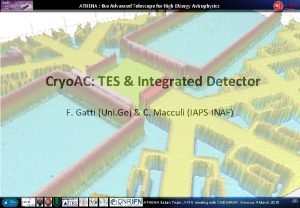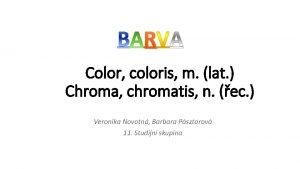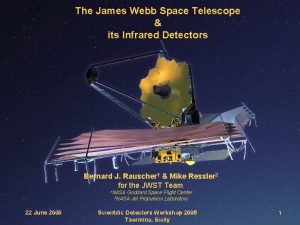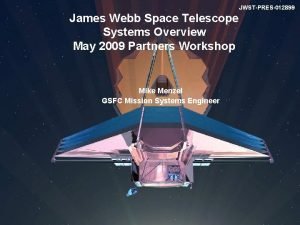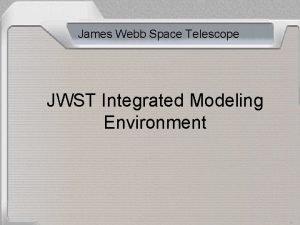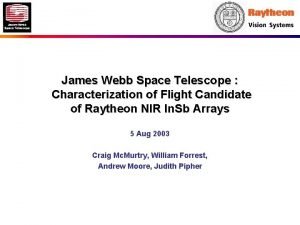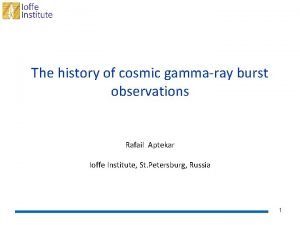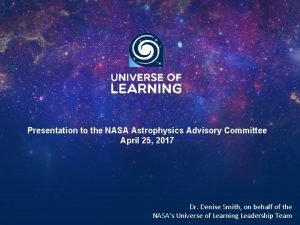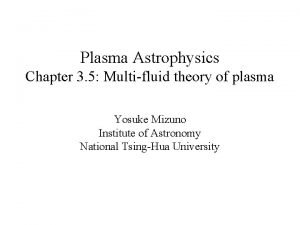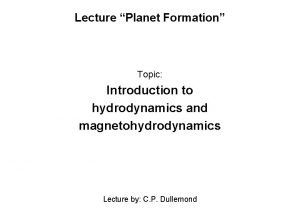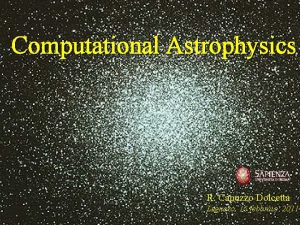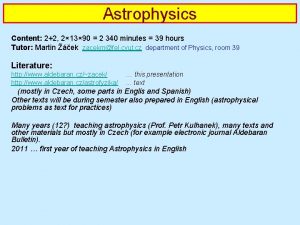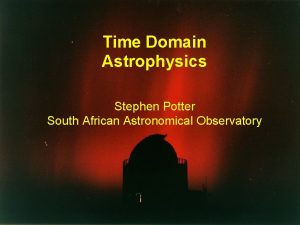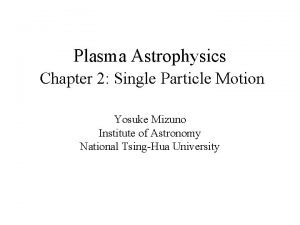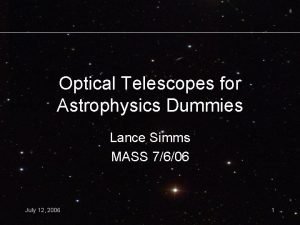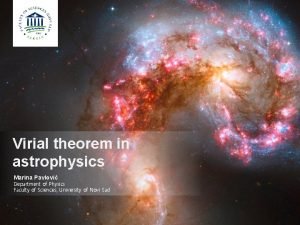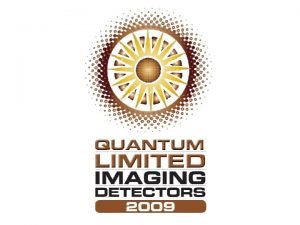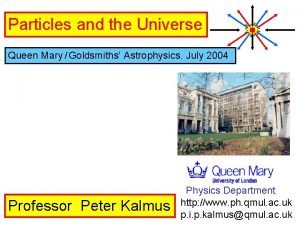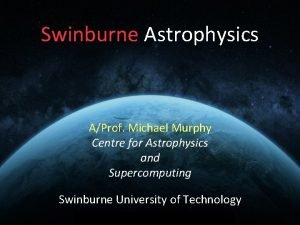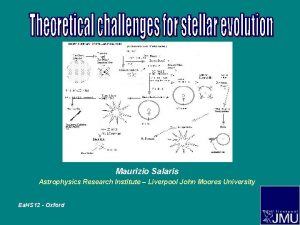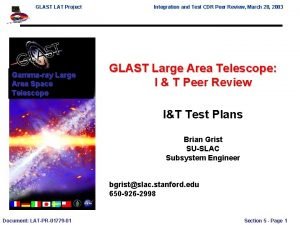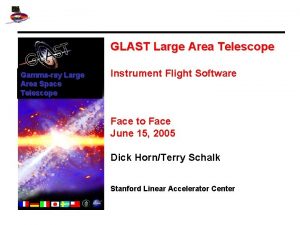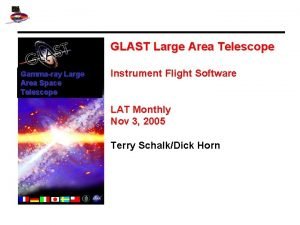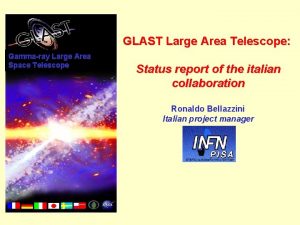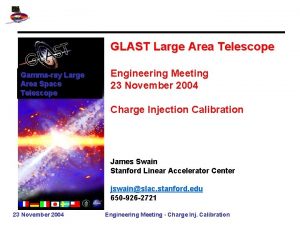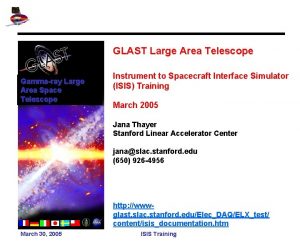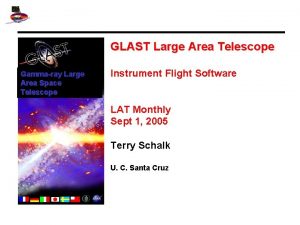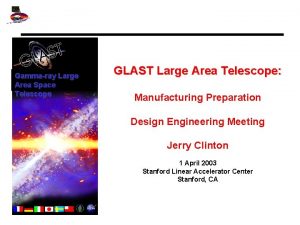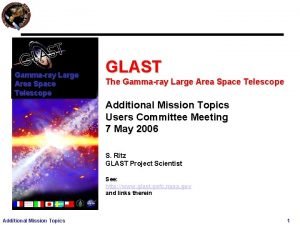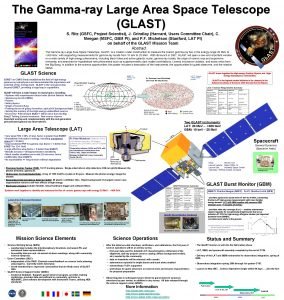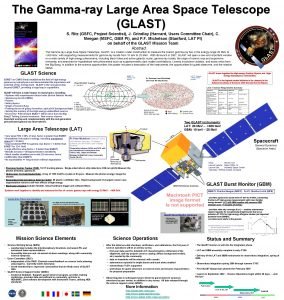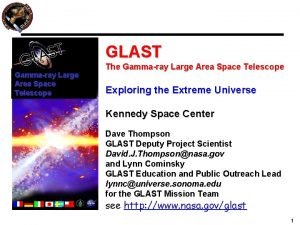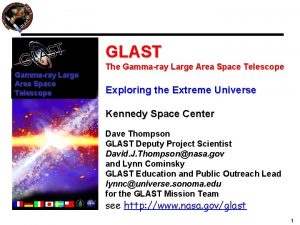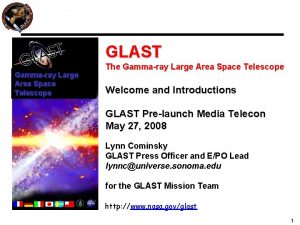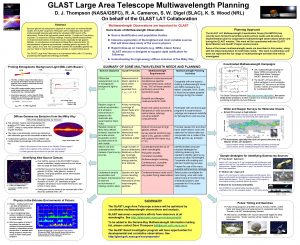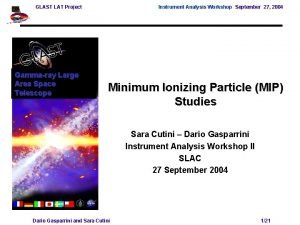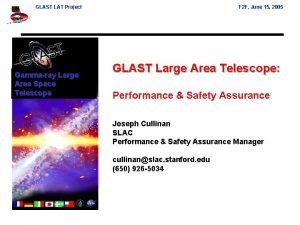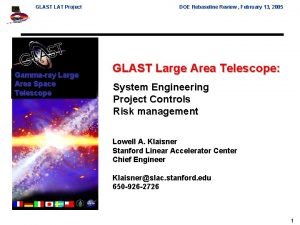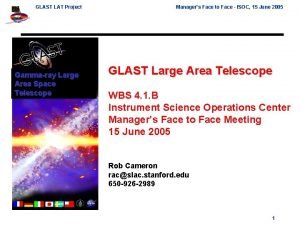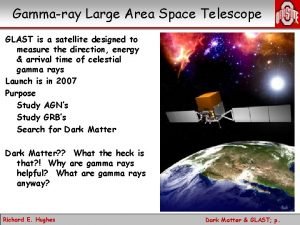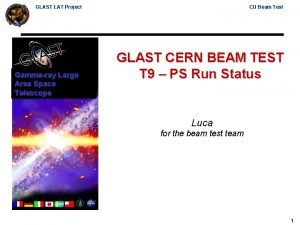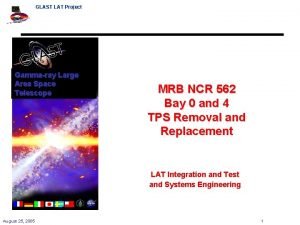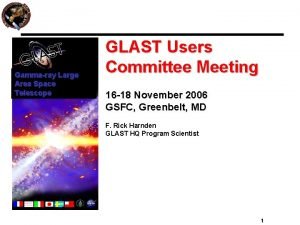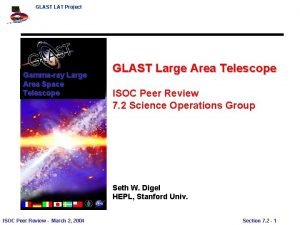Gammaray Large Area Space Telescope Particle Astrophysics GLAST

























- Slides: 25

Gamma-ray Large Area Space Telescope Particle Astrophysics: GLAST Peter F. Michelson Principal Investigator and Spokesperson, GLAST LAT Collaboration Department of Physics & SLAC, Stanford University SLAC Scientific Policy Committee Meeting: May 12, 2001

Gamma-ray Large Area Space Telescope GLAST Observatory GLAST Mission • spacecraft • LAT • GBM § high-energy gamma-ray observatory; 2 instruments - Large Area Telescope (LAT) - Gamma-ray Burst Monitor (GBM) § launch (Sept 2005): Delta 2 class § mission operations § science - LAT Collaboration - GBM team - Guest Observers § lifetime: 5 years (minimum) LAT Inst. Ops. Center Routine Data Alerts Large loads TOO commands LAT Data Spacecraft, GBM data Status Command Loads Mission Ops Center Observatory safety Spacecraft health Commanding Mission scheduling GBM data handling LAT data handling Instrument performance Level 0, 1 data processing Science Support Center Schedules Spacecraft data for archiving Science scheduling Archiving Guest Observer Support Standard product processing Burst and transient Alerts GRB Coordinates Network Status Command Loads GBM Inst. Ops. Center Instrument performance Standard product processing SLAC Scientific Policy Committee Meeting: May 12, 2001

Large Area Telescope (LAT) Point Spread Function 0. 35 o @ 1 Ge. V 0. 1 o @ 10 Ge. V Wide Field of View (2. 4 sr) > 40 times the sensitivity of EGRET Large Effective Area (20 Me. V – 1 Te. V) Low dead time: < 20 ms e+ e– Good Energy Resolution (DE/E ~ 10%) SLAC Scientific Policy Committee Meeting: May 12, 2001

GLAST Science: Simulated All Sky Map Virgo Region (E > 1 Ge. V) => many science objectives One-Year All-Sky Map (E > 100 Me. V) SLAC Scientific Policy Committee Meeting: May 12, 2001

One Year Point Source Catalog 5 s sources from Simulated All Sky Survey AGN Galactic plane 3 EG catalog EGRET 3 rd Catalog: 271 sources Galactic halo Expected GLAST LAT 1 st Catalog: ~10, 000 sources SLAC Scientific Policy Committee Meeting: May 12, 2001

GLAST Science Topics • Active Galactic Nuclei • Isotropic Diffuse Background Radiation • Cosmic Ray Production: – Identify sites and mechanisms • Endpoints of Stellar Evolution – Neutron Stars/Pulsars – Black Holes • Unidentified Gamma-ray Sources • Dark Matter • Solar Physics • Gamma-Ray Bursts • DISCOVERY! SLAC Scientific Policy Committee Meeting: May 12, 2001

Science capabilities - sensitivity large field-of-view 100 s 200 bursts per year prompt emission sampled to > 20 µs AGN flares > 2 mn time profile + E/E acceleration 1 orbit physics of jets and bursts delayed emission all 3 EG sources + 80 new in 2 days 1 day periodicity searches (pulsars & X-ray binaries) 3 EG limit 0. 01 1 yr catalog 0. 001 pulsar beam & emission vs. luminosity, age, B 104 sources in 1 -yr survey AGN: log. N-log. S, duty cycle, emission vs. type, redshift, aspect angle extragalactic background light ( + IR-opt) LAT 1 yr 2. 3 10 -9 cm-2 s-1 new sources (µQSO, ext. galaxies, clusters) SLAC Scientific Policy Committee Meeting: May 12, 2001

International Collaboration • access to X-ray, Me. V, and Te. V observatories by collaboration for multi-wavelength observations • ‘mirror’ data site in Europe ~ 100 collaborators from 28 institutions Organizations with LAT Hardware Involvement TKR CAL ACD CAL TKR Stanford University & Stanford Linear Accelerator Center NASA Goddard Space Flight Center Naval Research Laboratory University of California at Santa Cruz University of Washington Commissariat a l’Energie Atomique, Departement d’Astrophysique (CEA) Institut National de Physique Nuclearie et de Physique des Particules (IN 2 P 3): Ecole Polytechnique, College de France, CENBG (Bordeaux) Hiroshima University Institute of Space and Astronautical Science, Tokyo RIKEN Tokyo Institute of Technology Instituto Nazionale di Fisica Nucleare (INFN): Pisa, Trieste, Bari, Udine, Perugia, Roma TKR CAL Institute of Technology (KTH), Stockholm Royal CAL SLAC Scientific Policy Committee Meeting: May 12, 2001

GLAST LAT Project: Recent & Upcoming Milestones • NRC Decadal Astronomy & Astrophysics Review ranks GLAST highest priority “moderate-size” space mission for next decade: Sept 2000; • 1 st joint DOE-NASA Pre-baseline “Lehman” Review of GLAST LAT Project: Feb 13 -15, 2001; • Launch date delayed 6 months due to NASA Mission funding issues, March 19, 2001: launch now March 2006; • NASA Independent Assessment Review of GLAST Mission completed in December 2000; recommended NASA funding augmentation for mission; • NASA Headquarters approves IA-recommended mission funding profile (consistent with March 2006 launch) including contingency funds to procure Delta II-H (“heavy”) launch vehicle if needed: April 10, 2001; • LAT Project preparing for DOE-NASA Baseline/PDR Review this October; • Preparing for Balloon Flight of Engineering Model, Summer 2001; • GLAST LAT Collaboration meeting scheduled for August 1 -2, 2001 at Stanford University SLAC Scientific Policy Committee Meeting: May 12, 2001

Status of International Arrangements • 2 International Agreements and 4 Mo. As still being negotiated: complete drafts exist for all agreements; 3 Mo. As signed (Japan & Sweden; UCSC); • International Agreements delayed because Implementing Arrangement and Mo. U between DOE and NASA not in place; – International agreements needed with CNES (French Space Agency) and ASI (Italian Space Agency); – Lack of International Agreement and Mo. A with France (CNES) has impacted calorimeter schedule; French team from CEA/Saclay and IN 2 P 3, but majority of funding from CNES; working issues night & day; SLAC Scientific Policy Committee Meeting: May 12, 2001

GLAST LAT Organization E/PO L. Cominsky, SSU Principal Investigator Collaboration Science Team P. Michelson, SU Instrument Scientist SSAC N. Gehrels, GSFC S. Ritz, GSFC Project Manager Instrument Design Team W. Althouse, SLAC T. Kamae, SLAC System Engineer Project Controls T. Thurston, SLAC T. Boysen, SLAC Electronics & DAQ Integration & Test G. Haller, SLAC M. Nordby, SLAC Performance & Safety Assurance Mech. Systems M. Nordby, SLAC TKR CAL R. Johnson, UCSC SLAC, Italy, Japan N. Johnson, NRL France, Sweden D. Marsh, SLAC ACD IOC Sci. Software J. Ormes, GSFC S. Williams, SU R. Dubois, SLAC Scientific Policy Committee Meeting: May 12, 2001

Collaboration Organization • Senior Scientist Advisory Committee • • • N. Gehrels, Chair P. Michelson, PI/Spokesperson G. Barbiellini, Italy R. Bellazzini, Italy E. Bloom, U. S. T. Burnett, U. S. P. Carlson, Sweden A. Djannati-Atai, France R. Dubois, U. S. • • • I. Grenier, France N. Johnson, U. S. R. Johnson, U. S. T. Kamae, Japan J. Ormes, U. S. S. Ritz, U. S. H. Sadrozinski, U. S. D. Thompson, U. S. K. Wood, U. S. – Advises PI/Spokesperson on science issues and science organization of collaboration – Implements collaboration membership policy and publication policy – Meets quarterly SLAC Scientific Policy Committee Meeting: May 12, 2001

Collaboration Organization • Instrument Design Team – Chaired by Instrument Technical Manager, T. Kamae – Deputy Chairs: R. Bellazzini (Italy), E. Bloom (US), J. Paul (France) – Reports to Project Manager, W. Althouse – Forum for exchange of information between subsystems to maintain coordinated design; resolve issues or refer to IPO for resolution – Membership includes all subsystem managers & key system engineering personnel – IDT members obliged to attend IDT meetings; meetings open to the Collaboration – Weekly video conference meetings SLAC Scientific Policy Committee Meeting: May 12, 2001

GLAST Mission Science Working Group • Advises the GLAST Mission Project on matters related to the scientific development of the GLAST mission Jonathan Ormes, Chair, GLAST Mission Project Scientist Guido Barbiellini, Italy Charles Meegan, (PI-GBM), USA Elliott Bloom, USA Peter Michelson, (PI-LAT), USA Patrizia Caraveo, Italy M. Pohl, (IDS), Germany Charles Dermer, (IDS), USA David Thompson, USA Brenda Dingus, (IDS), USA Steve Thorsett, (IDS), USA Neil Gehrels, Deputy Proj. Scientist, USA Steve Ritz, Deputy Project Sci. , USA Isabelle Grenier, France Neil Johnson, USA Tuneyoshi Kamae, Japan Giselher Lichti, (GBM), Germany Lynn Cominsky, E/PO Don Kniffen, ex officio, Program Scientist * GLAST LAT Collaboration Members SLAC Scientific Policy Committee Meeting: May 12, 2001

GLAST Large Area Telescope (LAT) Design Instrument Pair-Conversion Telescope Pair-conversion telescope anticoincidence shield Instrument must measure the direction, energy, and arrival time of high-energy conversion foil photons (20 Me. V - >300 Ge. V) particle tracking detectors e+ e– calorimeter (energy measurement) - limitations on angular resolution (PSF): low E: multiple scattering many thin layers high E: hit precision & lever arm Photon cross-section in lead - interactions dominated by pair-conversion: determine photon direction clear signature for background rejection - energy resolution requires calorimeter depth sufficient to measure buildup of EM shower. calorimeter segmentation useful for resolution & background rejection SLAC Scientific Policy Committee Meeting: May 12, 2001

Large Area Telescope (LAT) Design Overview Instrument 16 towers modularity height/width = 0. 4 large field-of-view Tracker Si-strip detectors: total of ~106 ch. Calorimeter hodoscopic Cs. I crystal array cosmic-ray rejection shower leakage correction shower max contained < 100 Ge. V Anticoincidence Detector Shield segmented plastic scintillator minimize self-veto e+ Flight Hardware & Spares 16 Tracker Flight Modules + 2 spares 16 Calorimeter Modules + 2 spares 1 Flight Anticoincidence Detector Data Acquisition Electronics + Flight Software e– 3000 kg, 650 W (allocation) 1. 75 m 1. 0 m 20 Me. V – 300 Ge. V SLAC Scientific Policy Committee Meeting: May 12, 2001

GLAST Large Area Telescope (LAT) Design Tracker Modules Si-strip detectors: fine pitch: 228 mm, high efficiency 12 front tracking planes (x, y): 3% x 12 = 0. 45 Xo reduce multiple scattering 4 back tracking planes (x, y): 18% x 4 = 0. 72 Xo increase sensitivity > 1 Ge. V Prototype of one of 18 Tracker trays (detectors top & bottom) e+ e– SLAC Scientific Policy Committee Meeting: May 12, 2001

GLAST Large Area Telescope (LAT) Design Calorimeter Modules Hodoscopic Imaging Array of Cs. I crystals: ~ 8. 5 rl depth PIN photodiode readout from both ends: 2 ch/xtal x 96 xtals/mod = 2, 944 ch segmentation allows pattern recognition (“imaging”) and leakage correction 8. 5 rl Mechanical Prototype of Carbon Cell Design SLAC Scientific Policy Committee Meeting: May 12, 2001

GLAST Large Area Telescope (LAT) Design Anticoincidence Shield Segmented, plastic scintillator tile array: high efficiency, low-noise, hermetic; segment ACD sufficiently and only veto event if a track points to hit tile ACD tile readout with Wavelength Shifting Fiber SLAC Scientific Policy Committee Meeting: May 12, 2001

Detector Performance Verified in Detailed Beam Tests Experimental setup in ESA for tagged photons: X Projected Angle 3 -cm spacing, 4% foils, 100 -200 Me. V Data Monte Carlo GLAST Data (errors are 2 ) Monte Carlo SLAC Scientific Policy Committee Meeting: May 12, 2001

PSF measured for “Flight-scale” Prototype Tracker Monte Carlo - Back Monte Carlo - Front Data - Back Data - Front SLAC Scientific Policy Committee Meeting: May 12, 2001

Energy Response measured for “Flight-scale” Prototype Calorimeter Module Correlation method Profile fitting Raw SLAC Scientific Policy Committee Meeting: May 12, 2001

The PSF as a function of the reconstructed energy for data and Monte Carlo simulation. The expected 1/E behavior is clearly seen. As the photon energy increases, multiple scattering becomes less important and the PSF decreases. At high energies the point spread function is dominated by the finite spatial resolution of the silicon detectors (60 microns). The thick radiators at the back of the tracker widen the point spread function by slightly more than a factor of 2. SLAC Scientific Policy Committee Meeting: May 12, 2001

Because of the calorimeter depth, the shower maximum is contained up to ~ 50 Ge. V at normal incidence. However, above a few Ge. V, a large amount of energy leaks out the back of the calorimeter, and the total energy measured is systematically less than the incident energy. We have employed two techniques to correct for the shower leakage. We show the raw and reconstructed energy for 20 Ge. V incident positrons. The resolution of the raw distribution is around 7%, while the reconstructed resolution is less than 4% by the correlation method and about 5% by profile fitting. The reconstruction method applied to Monte Carlo simulated data yields an energy resolution of 3%, suggesting that some uncertainties remain in our calibration of beam test data. SLAC Scientific Policy Committee Meeting: May 12, 2001

Schedule Calendar Years 2000 2002 2001 2003 2004 I-CDR SRR PDR NAR (Joint DOE/NASA Review) Formulation Begin LAT-S/C Integration M-CDR 2006 Baseline Review 2011 Launch Implementation Build & Test Engineering Models Flight Units 1 st Joint DOE/NASA Review of GLAST LAT 2005 Ops. Inst. I&T Observatory I&T Schedule Reserve SLAC Scientific Policy Committee Meeting: May 12, 2001
 Advanced telescope for high energy astrophysics
Advanced telescope for high energy astrophysics Ops epo
Ops epo Lingua villosa alba
Lingua villosa alba High definition space telescope
High definition space telescope James nasa says space launch its
James nasa says space launch its Ote
Ote James webb space telescope
James webb space telescope Raytheon james webb space telescope
Raytheon james webb space telescope James webb nasa space telescope launch
James webb nasa space telescope launch Ioffe
Ioffe Working with models
Working with models Astrophysics equations
Astrophysics equations Astrophysics equations
Astrophysics equations Astrophysics
Astrophysics Astrophysics syllabus
Astrophysics syllabus Time domain astrophysics
Time domain astrophysics Astrophysics
Astrophysics Astrophysics for dummies
Astrophysics for dummies Virial theorem in astrophysics
Virial theorem in astrophysics Rit astrophysics
Rit astrophysics Queen mary astrophysics
Queen mary astrophysics Swinburne astrophysics
Swinburne astrophysics Maurizio salaris
Maurizio salaris A small, solid particle that travels through space.
A small, solid particle that travels through space. How large is space
How large is space How large is space
How large is space
